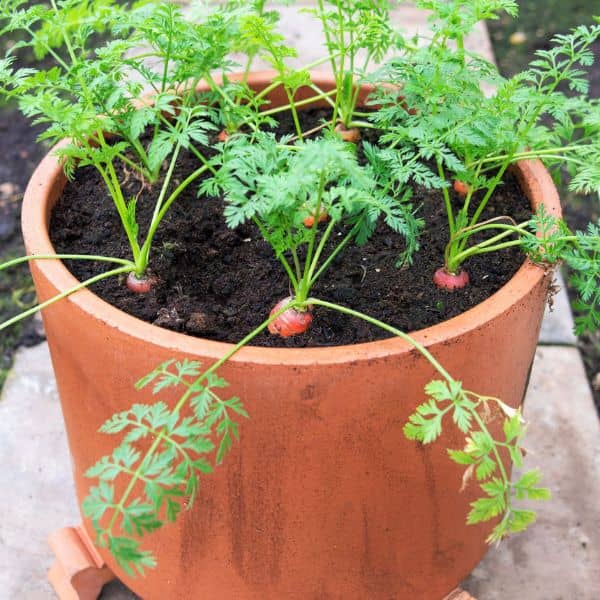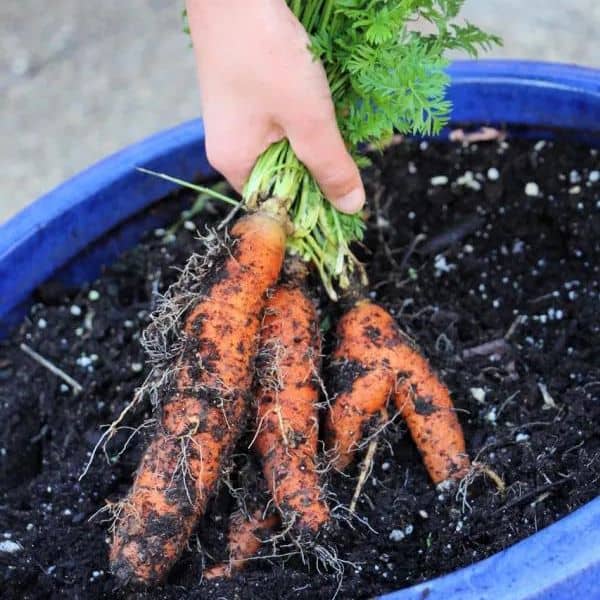Do you want to enjoy the fresh homegrown vegetables in your home- but worried about the limited garden space? Well, we have a solution for you! It is possible to grow fresh sweet carrots no matter how small your backyard is or if you don’t have a backyard at all.
Carrots were originally planted directly into the soil, however, they can just be cultivated in containers, on patios, balconies, or rooftops, or in any other limited space you may have. It is relatively easy to grow carrots in the container but it will require a bit of planning, time, and care to yield succulent carrots from your container garden.
All you need to start growing carrots is some basic steps and place located in a sunny area and you can harvest fresh carrots right in front of your doorstep for the whole season.
Select the correct container for growing carrot
Choose a container that has at least 12 inches depth and drainage holes, this will enable the carrot taproot to grow big enough since the part of the carrot that we consume is the taproot. Some good container options to include are:
10-gallon grow bags, such bags are made of aeration fabric, considered best for root crops. This enables air to pass through containers and also for drainage.
5-gallon buckets, Carrots can be grown in ordinary 5-gallon plastic buckets but those with prefilled drainage holes are used for planting plants such as flowers and fruits. When planting in 5 gallon grow bag, you will need around 5-10 gallons of soil mix.
10-gallon plastic flower pots, pots are also similar to grow bags and provide sufficient space for carrots to grow erect.

Caring Tips for Carrots Grown in Containers
Soil Mix
Carrots on the other hand need loose structure and nutrient-dense soil for them to grow well. The use of garden soil should not be considered because it turns out to be very compact.
You can also buy ready, organic potting soil mixture for vegetables at most of the gardening ships. Either way, you need to be very particular about the drainage of your soil mixture. The soil mixture used for potting carrots should be one that has a lot of space and can enable the plants to grow, and rich in organic materials, as they also enjoy delicious nutrient-rich super soil!
Watering
The soil should be moist all the time but remember not to make it waterlogged. It is suggested that the water should be given once the upper layer of the soil becomes dry, which is usually to the depth of about an inch.
Lack of water will hinder the growth of the plant, and a lot of water will also harm it. Water the plants moderately and let them dry out a bit in between the waterings.
Light Requirements
It is recommended that the container you are growing the carrot should receive more than 6 hours of direct sunlight every day for proper growth and development of their characteristics and orange flavor. As it is pointed out if there is less sun, there will be less growth.
Fertilizer
Fertilizer should be given once with a balanced vegetable fertilizer a couple of weeks after germination, and once after the midpoint in growth, doing this will provide nutrients for good growth to the plants than using manure and taking a longer time to get nutrients for the growth of the plants.
Growing Carrot: Planting the Seeds

Once your containers are conditioned with soil, planting starts!
- Plant the seed 2-3 months before the last frost date of the season, if you are growing the plants outdoors, as carrots are classified as a cool season vegetable that may take 70-80 days to mature.
- Spread the seeds over the surface so that there is equal distribution of seeds in the container.
- After planting, allow the seeds to be covered by about 1/4 inch of layer of soil mix.
- Water the seeds well.
- Check the moisture of the soil daily to maintain a slightly moist environment at all times, but not waterlogged.
- After around 12-18 days the carrot seedlings will start to emerge and should be thinned so that plants are roughly two inches apart.
- Fertilizer in organic vegetable fertilizer per package direction every 2-3 weeks.
Problems while growing Carrot
Organic carrot cultivation in containers is interesting but complications might be seen, here are some common problems and solutions:
Leggy Seedlings
Some stems of the plant have elongated beyond the usual space between two consecutive leaf options resulting from lack of sunlight.
Becomes Mushy
Carrots fail to grow to their normal size because the soil becomes compacted. To avoid damaging the plant, it is recommended to remove it gently using fingers or a tool, likewise water with more moderation.
Stunted root systems
Growing in compact soils reduces root growth in the downward direction. Make the soil less compacted by adjusting the composition of the soil to be less compacted and more permeable.
Damaged Tips
Due to the water logging of the plants, they are stressed through underwatering, watering the plants more often, and checking the soil moisture level often.
Nutrient Deficiency
Nutrient deficiencies cause pale leaves and weak stems and root rot is the result of fungi attacking roots. Place fabric barriers over the covering of the container to help minimize.
FAQs
1. What type of container should I use for growing carrots?
Your container should be deep enough to hold the carrots’ long root i.e. at least 12 inches deep, while the best containers are those with bottom drainage holes made of plastic, ceramic, or wood.
2. What kind of soil is best for growing carrots in containers?
Carrots require a light, well-draining potting mix. A mix of potting soil and sand or perlite can improve drainage, whereas you should avoid heavy garden soil that can compact and hinder root growth.
3. How long does it take for carrots to mature in containers?
Most carrot varieties mature in 60-80 days, you can check the seed packets for specific days to maturity for your chosen variety.
Read more on, Orange Delight: 10 Trees That Bloom Stunning Orange Flowers
